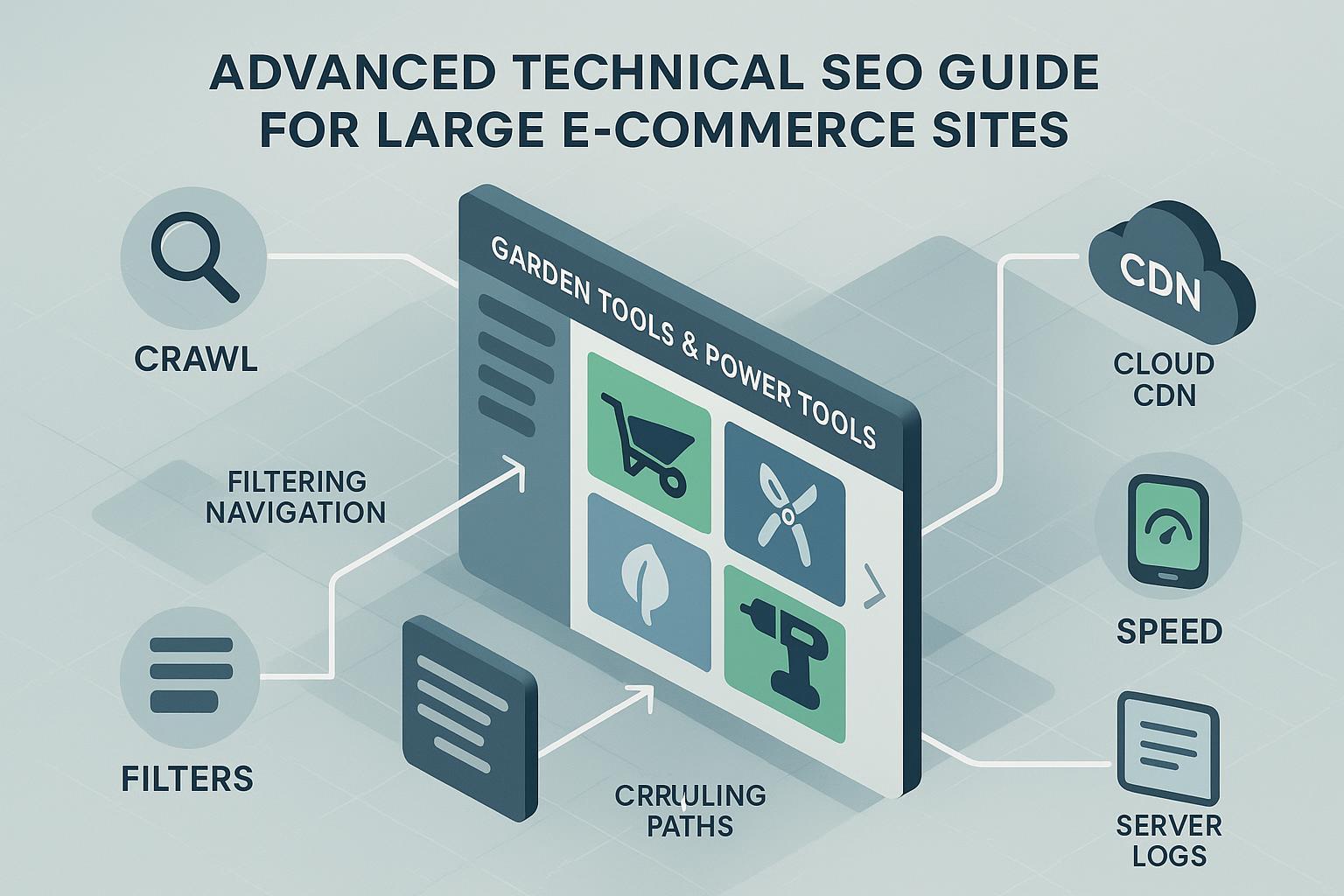Technical SEO Best Practices for Power Tools & Garden Tools E-commerce: Crawl Budget, Faceted Navigation & Page Speed (2025)

Introduction
In the power tools and garden tools e-commerce sector, technical SEO determines whether your vast catalog of SKUs converts into organic visibility and revenue—or languishes unindexed. Large inventory sites introduce challenges: massive crawl footprints, faceted navigation sprawl, and conversion-critical page speed, especially across desktop and mobile. Addressing these demands is essential for SEO professionals and web engineers serious about winning high-ROI traffic in 2025 and beyond.
1. Crawl Budget Optimization: Proven Tactics for High-SKU Retail Sites
Maximize priority page indexation and search visibility by streamlining site architecture, controlling duplicate URLs, and leveraging Google crawl data.
-
Map and Flatten Site Architecture
Keep your website's product depth to two clicks from home/category. Flat navigation (category hubs, logical breadcrumb trails) speeds bot traversal and prioritizes product landing pages (Google Search Central). -
Control Duplicate & Parameterized URLs
Use canonical tags for all variants. Block irrelevant filter/search parameters in Google Search Console's URL Parameters tool. Minimize crawl waste by ensuring unique value pages only (PageOptimizer Pro). -
Dynamic XML Sitemaps for Large Catalogs
Submit frequently updated XML sitemaps, prioritizing high-traffic SKUs and new products. Segment sitemaps by category (e.g., drills, lawn mowers) for focused recrawling. -
Server Log Analysis & Crawl Monitoring
Regularly analyze server logs to identify crawl inefficiencies (dead ends, redundant URLs). Use Screaming Frog and Google Search Console Crawl Stats for actionable insights (Screaming Frog). -
Submit & Audit Key URLs Manually
Expedite indexation for new/top-category pages by submitting URLs via GSC's URL inspection. Monitor index coverage reports—especially on high-value seasonal SKUs.
Benchmark: Sites optimizing crawl budget see faster indexation, fewer unindexed URLs, and notable ranking gains for new products (Google, Conductor).
2. Faceted Navigation SEO: Filter Management for Crawl Efficiency & Ranking
Faceted navigation can create crawl traps and duplicate content—implement advanced controls for SEO and user experience.
-
Canonicalization of Facet URLs
All facet (filter) URLs should canonically link to their primary category page or unique filter landing if value added. Prevent dilution with canonical tag and robots.txt controls (Ahrefs Guide). -
Selective Indexation (Noindex Low-Value Filters)
Apply noindex,follow meta tags for redundant or low-value filter combinations (e.g., color+size with no unique content). Use logic from audit tools to automate which combinations remain indexed (Search Engine Journal). -
Parameter, Robots.txt, and AJAX Controls
Block non-SEO-critical parameters; leverage AJAX updates for user state filters (with pushState for indexable cases). Disallow crawl of pure session or blank result filters via robots.txt. Audit with Screaming Frog and Ahrefs Site Audit. -
Internal Linking with Breadcrumbs & Hubs
Use breadcrumbs and navigation hubs to direct link equity and structured crawling from facets to core categories, strengthening both indexation and user experience.
Case Study: Zalando implemented canonical tags, hreflang, selective filter indexation and unique H1 content on facet pages. Result: Increased long-tail rankings, reduced duplicate content, and improved internationalization. (Zalando, detailed in SEJ).
3. Page Speed Optimization: Conversion & Ranking in Large-Catalog E-Commerce
Page speed directly impacts user experience and conversion rates; every second matters.
-
Optimize Above-the-Fold and Image Assets
Compress and correctly size product images; implement lazy loading. Benchmark using PageSpeed Insights and Core Web Vitals (CLS, INP). Target <2 second LCP across devices (BrowserStack). -
Enable HTTP/2, CDN & Browser Caching
Migrate to HTTP/2 for faster asset delivery. Deploy CDN (especially for images, videos), and configure browser/server caching for all category/product pages. -
Reduce Scripts, Minify JS/CSS, Prioritize Mobile
Remove unnecessary third-party scripts; minify assets and streamline code delivery. Emphasize mobile speed as 70%+ tool/garden retail traffic originates from smartphones (Highervisibility). -
Monitor, Iterate & Benchmark
Establish Core Web Vitals monitoring (Google Search Console, SpeedLab by BrowserStack) for ongoing sector benchmarks. Track conversion rates in tandem with speed upgrades: retail sector averages 5.6% conversion lift per 1s improvement (BrowserStack).
Industry Example: eBay’s focus on above-the-fold speed and asset reduction resulted in 12% quicker loads and 0.5%+ conversion improvement. (Conductor case)
4. Implementation Table: Sector-Specific Technical SEO Framework
| Practice Area | Best Practice | Sector Example/Tool | Impact Benchmark |
|---|---|---|---|
| Crawl Budget | Flatten site, control parameters, dynamic XML | Screaming Frog, GSC, Zalando | 2-click depth; faster SKU indexation |
| Navigation | Canonical URLs, selective noindex, robust breadcrumbs | Ahrefs, Zalando case | Reduced duplicate crawl, long-tail traffic |
| Page Speed | LCP <2s, HTTP/2 & CDN, mobile optimization | BrowserStack, eBay case | 5.6%+ conversion increase |
- Detailed audit guides: Moz Page Speed Guide, Sitebulb Crawl Budget Insights
- Tool walk-throughs: Screaming Frog SEO Spider, Ahrefs Site Audit
- Full sector benchmarks: BrowserStack SpeedLab
5. Actionable Technical SEO Checklist for Power Tools & Garden Tools E-commerce
- [ ] Site architecture depth ≤2 clicks from home to product
- [ ] Canonical and parameterization review for all URLs
- [ ] Dynamic XML sitemap segmented by category
- [ ] Server log review and GSC Crawl Stats weekly
- [ ] Faceted navigation audited for indexation, duplicate, filter value
- [ ] Meta noindex applied to all low-value filter pages
- [ ] Breadcrumb navigation present and structured
- [ ] Images compressed/lazy loaded; CDN active
- [ ] HTTP/2 enabled; JS/CSS minified for all pages
- [ ] Core Web Vitals monitored across all devices
- [ ] Conversion rate tracked post-speed upgrades
Conclusion
Power and garden tools retailers face unique technical SEO challenges—but by implementing these advanced, actionable best practices, you’ll ensure crawl efficiency, indexation growth, and speed-driven conversion wins. Industry leaders prove the ROI: optimized crawl budget means more SKUs in search; well-managed navigation avoids duplicate traps; and faster sites boost sales. Regular audits, tool-powered insights, and sector benchmarking will keep your e-commerce ahead of the curve.
For further reading:
- Google’s SEO Crawl Budget Insights
- Ahrefs: Faceted Navigation SEO
- BrowserStack: Ecommerce Page Speed Guide
Stay technical, stay competitive. Your catalog’s visibility depends on it.

